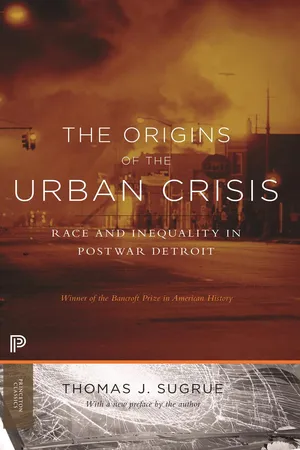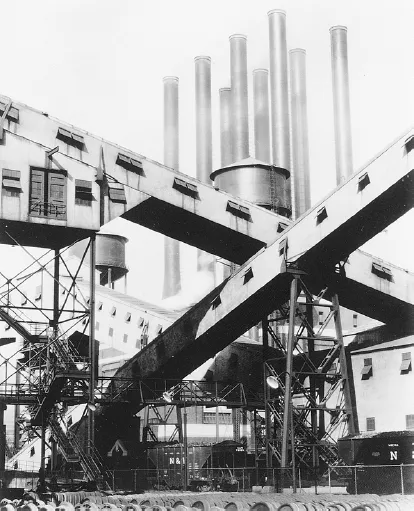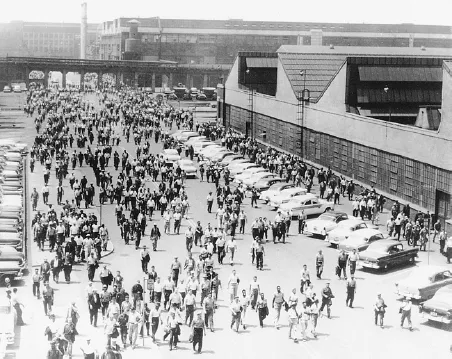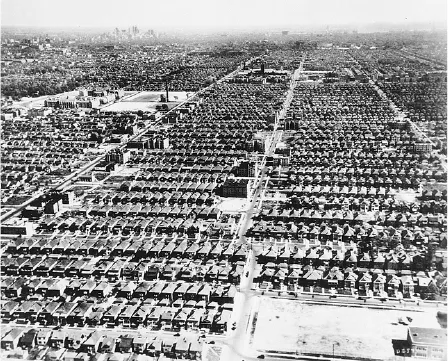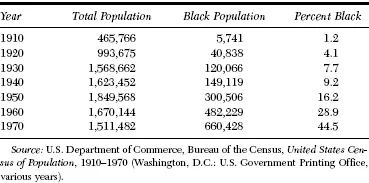![]()
Part One
ARSENAL
![]()
1.1. The enormous Ford River Rouge plant, one of the largest industrial complexes in the world, was a symbol of Detroit’s industrial might. In 1927, photographer Charles Sheeler captured the might of the Rouge in his view of “Criss-Crossed Conveyors.” At the end of world War II, over eighty-five thousand workers were employed in the sprawling complex. The River Rouge plant was also Detroit’s major employer of African Americans in the wartime era.
1
“Arsenal of Democracy”
IN 1927, Charles Sheeler photographed the Ford Motor Company’s enormous River Rouge plant. His most famous print depicts two starkly angular conveyor belts that transported coal into the power plant. In the background piercing the sky are eight tall, narrow smokestacks. Sheeler’s striking image revealed the might of Detroit’s industry, and did so by portraying only one small section of an industrial complex that consisted of nineteen separate buildings covering more than two square miles. The Rouge included a manmade harbor for Great Lakes coal and iron barges, the largest foundry in the world, and ninety-two miles of railroad track. In 1933, Mexican muralist Diego Rivera captured the monumentality of automobile production at the Rouge. His frescoes at the Detroit Institute of Arts depict workers dwarfed by furnaces belching fire, engaged in seemingly mortal combat with machinery so overwhelming that it called forth herculean labors.1 These powerful images of Detroit conveyed the sense that the city was the very essence of American industry.
Mid-twentieth-century Detroit embodied the melding of human labor and technology that together had made the United States the apotheosis of world capitalism. Visitors flocked to the Motor City to marvel at its industrial sites. Crowded into the observation areas at auto plants, they stood rapt as the twentieth century’s premier consumer object, the automobile, rolled off the assembly lines by the dozens an hour. The scene was a drama of might and violence, of human ingenuity and sheer physical labor, punctuated by the noise of pounding machinery, the sight of hundreds of workers moving rhythmically to the pulse of the line, the quiet but never unnoticed hovering of foremen and inspectors, the interplay of mechanical power and the brawn of human arms and backs, the seemingly endless rush of workers through the gates at shift change time. Detroit’s brooding horizon of factories and its masses of industrial laborers became icons of modernity.
Sheeler’s photographs and Rivera’s murals depicted one part of Detroit: its role as a center of mass production. Ford, Chrysler, and General Motors had their headquarters in the Detroit area. The outlines of dozens of major automobile plants punctuated the low skyline of Detroit. Some, like Dodge Main in Hamtramck, nearly as large as the Rouge, loomed on the horizon; others, like the Packard plant on East Grand Boulevard, spread out over several long city blocks. But throughout the city were many less imposing but still significant enterprises. Also prominent on the city’s landscape were a score of large plants where car parts were built: several stamping plants that produced car bumpers and chassis frames, a number of engine plants, one of the largest tire manufactories in the country, and four independent car body manufacturers.2
Thousands of relatively inconspicuous factories lined Detroit’s major thoroughfares, most employing a few hundred workers, too ordinary in their design and function to attract the attention of artists like Sheeler and Rivera, but no less essential to the city’s economy. “Around the work-stained skirts of the town,” noted a reporter in 1955, sprawl “miles of one-cylinder tool-and-die shops.” The production of a car involved the assembly of thousands of small parts, the building of hundreds of machine tools, the stamping of dies, the forging of metal, the casting of tubes and coils and springs, the molding of plastics, and the manufacture of paints, glass, fabrics, bearings, electronics, and wire. To supply machinery and parts to the automobile industry, a myriad of small manufacturing operations thrived around the city.3
To focus merely on the automobile-related factories would miss whole sectors of Detroit’s industrial economy. Over 40 percent of the city’s industrial jobs were in nonautomotive plants. Some were descended from nineteenth-century enterprises: stove making, brewing, furniture building. Also in Detroit were chemical companies, aircraft part fabricators, oil refineries, salt mines, steel mills, garment manufacturers, food processing plants, the largest pharmaceutical manufacturer in the world, and a major producer of adding machines and typewriters.
Early twentieth-century Detroit was, in the words of historian Olivier Zunz, a “total industrial landscape.” Factories, shops, and neighborhoods blurred together indistinguishably, enmeshed in a relentless grid of streets and a complex web of train lines. To the casual observer, the design of Detroit seemed anarchic. The city’s sprawling form and its vast array of manufactories made little sense. But Detroit’s industrial geography had a logic that defied common observation. Rail lines formed the threads that tied the city’s industries together. Automobile manufacturing and railroad transportation were inseparably bound in a symbiotic relationship. Every major automobile factory had its own rail yard. Plants were, in the eyes of one observer, “ringed round with…snarls and tangles of railroad tracks.” Trains brought raw materials and parts to the auto plants and carried the finished products to distributors throughout the country.4
The Detroit River was another essential element in the city’s industrial geography. The fast-flowing channel that marked the southern and eastern boundaries of the city passed by Detroit’s steel mills and chemical plants. Its waters provided egress to the Great Lakes and easy access to coal and ore, which were prohibitively expensive to transport by land. Chemical and steel manufacturers also depended on water for their cooling systems, and on the river as a ready place to discharge industrial wastes.
In the age of the truck and automobile, roads were a vital conduit linking Detroit’s numerous industries to each other. Five wide arterial avenues—Michigan, Jefferson, Gratiot, Woodward, and Grand River—the remnants of Pierre L’Enfant’s neoclassical, early national plan for the city—allowed for speedy transit in and out of the city center. A network of surface streets, laid out by nineteenth-century planners in an enormous checkerboard, proved tremendously convenient for the speedy transport of car parts, machine tools, and casts and dies from the small plants where they were built to the larger plants that put them to use in car production. Suppliers and machine tool companies, and other smaller operations, fanned out throughout the city, generally within short range of auto plants, but not confined to the riverside or to railroad rights-of-way.5
In the early 1940s, Detroit was at its industrial zenith, leading the nation in economic escape from the Great Depression. Between 1940 and 1947, manufacturing employment in Detroit increased by 40 percent, a rate surpassed only by Los Angeles, San Francisco, and Chicago. Demand for heavy industrial goods skyrocketed during World War II, and Detroit’s industrialists positioned themselves to take advantage of the defense boom. Detroit’s automobile manufacturers, led by Ford, quickly converted their assembly lines to the mass production of military hardware, airplanes, tanks, and other vehicles, making metropolitan Detroit one of the birthplaces of the military-industrial complex. Observers christened the city “Detroit the Dynamic,” the “arsenal of democracy” for a war-torn world. Almost overnight, Detroit had gone from one of the most depressed urban areas in the country to a boomtown, a magnet that attracted workers from all over the United States. The demand for manufacturing labor seemed boundless. Thousands of newcomers flooded the city, coming from places as diverse as rural Appalachia, depressed farm counties in central Michigan, Ohio, and Indiana, and the declining Black Belt regions of the Deep South. The rapid expansion of wartime production drastically reduced unemployment in the city. Between 1940 and 1943, the number of unemployed workers in Detroit fell from 135,000 to a mere 4,000.6
The workers who toiled in Detroit’s factories forged some of the nation’s most powerful trade unions. The end of the Great Depression and the onset of World War II marked the triumph of industrial unionism in Detroit. In the late 1930s, the United Automobile Workers battled the major automobile manufacturers in a series of sitdown strikes, pickets, and protests. The UAW brought together industrial workers from a wide range of ethnic and cultural backgrounds—Lithuanians, Hungarians, Poles, Jews, Scottish, Irish, Mexicans, Canadians, Lebanese, Palestinians, Italians, Germans, and many more. It overcame initial resistance from African Americans whose church and community leaders were suspicious of trade union activity and from southern white migrants who often worshipped in staunchly antiunion storefront churches and belonged to organizations like the Black Legion and the Ku Klux Klan. The UAW and other industrial unions succeeded in obtaining relatively high wages and benefits, and some job security, for a sizable fraction of Detroit’s manufacturing workers. Still, especially in the 1940s, the shop floor was a battleground of contesting visions of unionism. White rank-and-file members protested the upgrading of black workers, unions split into left-led and centrist factions, and union leaders alternated between militance and accommodation with employers.7
1.2. In the 1940s, Detroit’s booming defense and automobile industries made the city a blue-collar mecca, magnet to tens of thousands of migrants who found relatively secure, well-paying jobs. At shift change time, shown here, workers rushed out of their plants, heading to their homes in Detroit’s innumerable working-class neighborhoods.
At the end of the workday, Detroit’s laborers rushed to their cars and to the trolleys and buses of the Detroit Street Railway, clogging the streets that led to the innumerable blue-collar neighborhoods of the city. Surrounding the smoky factories of Detroit and spreading out for miles and miles on the horizon in every direction was a sea of frame and brick houses. “The protoplasmic cells of Detroit,” observed traveler Edmund Wilson, “are…drab yellow or redbrick houses, sometimes with black rock-candy columns or a dash of crass Romanesque.” Lining the streets of the city’s “Polak and Negro sections” were “little dull one-story frame houses.” However “small, square, [and] ugly” they might appear to an outsider, two-thirds of all residential structures in the city were single-family homes and another one-fifth were two-family homes. The city’s skyline was unassuming, for outside of downtown with its Art Deco skyscrapers and the industrial areas with their multistory factories and belching smokestacks, Detroit had virtually no tall buildings. Unlike its east coast counterparts, Detroit lacked both tenements and high-rise apartments. Only 1.3 percent of the city’s residential structures were apartment buildings. A quintessential twentieth-century city in its amorphous sprawl, Detroit lacked the density of older cities in large part because of the vast amount of open land available within the city’s boundaries as late as mid-twentieth century. In most parts of the city, the highest visible buildings were church steeples, most of them monuments to the religious fervor and diligence of Catholic immigrants.8
1.3. Detroit’s West Side was home to tens of thousands of blue-collar workers whose single-family detached homes made Detroit a low-rise city.
Detroit in the 1940s was also a city rife with social tensions. By the outbreak of World War II, the geography of Detroit had come to be defined in terms of white and black. This racial division of the metropolis came in the wake of the dissolution of ethnic communities. By the 1920s, the city’s tightly knit ethnic clusters had begun to disperse, and fewer and fewer white neighborhoods were ethnically homogeneous. Important and highly visible immigrant enclaves like Polish Hamtramck and Hungarian Delray continued to exist throughout the twentieth century, but a dwindling number of Detroit residents found themselves living in communities defined by ethnicity. Beginning in the 1920s—and certainly by the 1940s—class and race became more important than ethnicity as a guide to the city’s residential geography. Residents of Detroit’s white neighborhoods abandoned their ethnic affiliations and found a new identity in their whiteness.9
There were many white Detroits. The Detroit of automobile company executives, bankers, lawyers, and doctors could be found in neighborhoods like Boston-Edison, where cathedral-like stands of elm trees towered over staid boulevards lined with ten- to twenty-room mansions, and Palmer Woods and Rosedale Park, whose curvilinear streets passed through a romantic landscape of mock-French châteaux, Tudor-style mansions, formal Georgian estates, and stately New England-style colonials. The Detroit of clerks, engineers, accountants, and midlevel white-collar workers consisted of more modest neighborhoods in the northwest and far northeast sections of the city, like West Outer Drive, Russell Woods, and Chalmers Park, where many lived in substantial three- and four-bedroom brick homes, small-scale versions of the architecture of Palmer Woods.10
The majority of white Detroiters lived in the lesser homes of the city’s innumerable blue-collar neighborhoods. Small bungalows, most of frame construction, some of brick, crowded together on twenty-five-by-one-hundred-foot lots that allowed just enough room for small vegetable gardens or flower patches. Many, like Oakwood in southwest Detroit, were huddled in the shadow of Detroit’s plants, offering their residents easy access to jobs. Increasingly, in the age of the automobile, blue-collar workers built neighborhoods far from the soot of older industrial sections of the city. Areas like Brightmoor on the far West Side, Courville on the Northeast Side, or De Witt-Clinton on the Northwest Side attracted workers who wanted a little green space and did not mind commuting to their jobs. Typical was Brightmoor, an area of one-story “white frame houses, built largely on wooden piles,” cheaply built “without adornment of any kind, and strictly utilitarian.”11 Whatever the condition of their houses, many working-class Detroiters had deep attachments to their neighborhoods and the houses they had built there. “It’s a pretty city,” recalled auto worker Mike Kerwin, comparing Detroit favorably to his hometown of Chicago. “Almost every street had trees all up and down.” Detroit was, above all, a city of homes.12
TABLE 1.1
Detroit’s Population, 1910–1970
Black Detroit in 1940 was large and rapidly growing. Like other major northern urban centers in the twentieth century, Detroit had a sizable black ghetto that had emerged in the midst of the World War I-era Great Migration of blacks from the South to the urban North. Detroit’s reputation as a city of unsurpassed economic opportunity, combined with wrenching changes in the southern economy, attracted thousands of new migrants northward to the Motor City. Migrants came with the hope that the booming northern city would be free of the harsh segregation that had perpetuated Jim Crow on the docks, in the mines, and in the warehouses of the South. Some observers called Detroit “the northernmost southern city” or “the largest southern city in the United States,” but it was, after all, a place where blacks could vote, ride side by side with whites on streetcars and buses, and share the same drinking fountains and bathrooms.13 In the wake of waves of migration, Detroit’s black population expanded dramatically over the course of the twentieth century (Table 1.1). Fewer than 10 percent of Detroit’s population at the outbreak of World War II, African Americans comprised more than a quarter of the city’s residents by 1960.
Detroit’s racial boundaries had their origins in the Great Migration of blacks to the city between 1916 and 1929. As early as the mid-nineteenth century, blacks had settled primarily on Detroit’s East Side, many in the small “Black Bottom” neighborhood just east of downtown. But blacks and recent immigrants in the nineteenth and early twentieth centuries shared the same streets; seldom did blacks find themselves concentrated in predominantly black neighborhoods. The Great Migration changed the racial geography of Detroit markedly. From the 1920s through the 1940s...
